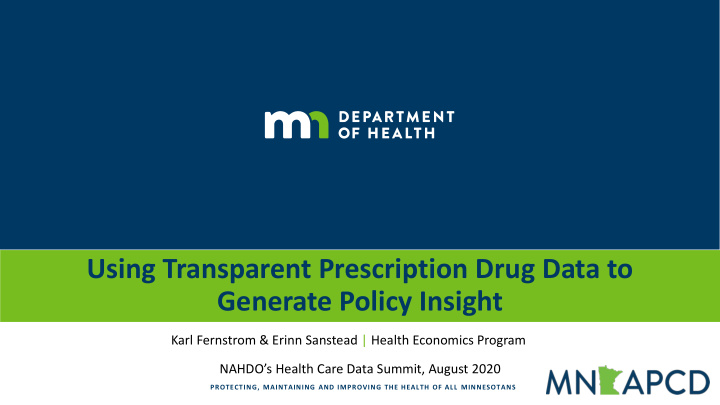



Using Transparent Prescription Drug Data to Generate Policy Insight Karl Fernstrom & Erinn Sanstead | Health Economics Program NAHDO’s Health Care Data Summit, August 2020 PROTECTING, MAINTAINING AND IMPROVING THE HEALTH OF ALL MINNESOTANS
Acknowledgements • Mathematica • Medical Industry Leadership Institute, University of Minnesota (UMN) • Health Economics Program, Minnesota Department of Health (MDH) 2
MN APCD Suite of Public Use Files (PUFs) • Publicly available summary data from the Minnesota All Payer Claims Database (MN APCD) ➢ Within statutory guardrails ➢ Relevant to current health policy topics ➢ Free to download online ➢ Accessible via user friendly spreadsheets 3
PUF Development – A Policy Driven Approach • Convene stakeholders from diverse settings to preview PUF designs and offer feedback to maximize PUF utility ➢ How would you envision using these PUFs? ➢ What analyses are of greatest public interest? ➢ How could these PUFs be used to help guide policy makers? 4
Prescription Drug PUFs WWW.HEALTH.MN.GOV
PUF Release • Two PUFs containing over 95% of pharmacy claims and their associated spending in the MN APCD for 2012 and 2016 ➢ 1,700+ non-proprietary drug names ➢ 11,000+ 2-segment National Drug Codes (NDC’s) • User guide with meta-data, example calculations, and data considerations • Data Short-Take with select use cases 6
PUF Variables • Prescription counts • Member counts • Means, medians, and standard deviations for amounts and quantities • Reference data from the FDA National Drug Code Directory 7
Example Use Cases WWW.HEALTH.MN.GOV
Growth in the Five-Year Cost per Script of Humira, by Payer 2012 2016 93% $2,513 MN Health Care Programs $4,840 88% $2,800 Medicare $5,275 66% $3,034 Commercial $5,042 $0 $1,000 $2,000 $3,000 $4,000 $5,000 $6,000 Cost per script Source: MDH, Health Economics Program analysis of MN APCD Prescription Drug Detail PUF. 9 Note: Retail prescription drugs only. Prices do not reflect rebates.
Demographics of Commercially Insured Individuals Prescribed Epinephrine (2016) Patient characteristic % of Scripts Age <19 years 49.4% 19 to 44 years 22.1% 45 to 64 years 25.4% 65+ years 3.1% Sex Female 52.8% Male 47.2% RUCA class Urban core 73.3% Suburban 12.1% Micropolitan 6.4% Rural/small town 8.2% 10 Source: MDH, Health Economics Program analysis of MN APCD Prescription Drug Summary PUF. Note: Retail prescription drugs only.
Interdisciplinary Health Data Competition WWW.HEALTH.MN.GOV
Competition Overview and Goals • Open to all graduate and professional-degree seeking students at UMN • Exploratory analysis of new PUFs • Generate innovative insights and ideas for policy action • Judged on relevance, analysis, and innovation 12
Select Team Topics • Economic burden of extended-release drugs • Medicaid over-the-counter prescription spending • Cost of diabetes treatment • Impact of COVID-19 on commonly prescribed respiratory drugs • Disparity between cardiovascular prescription utilization and coverage • Impact of generic drug options 13
The Economic Burden of Extended Release Pharmaceuticals in Minnesota 14
Policy WWW.HEALTH.MN.GOV
APCDs Inform Health Policy • Broad APCD use has more impact • Policy makers rely on high quality data • Policies need robust analyses to ensure they are working as intended 16
Pharmaceutical Policy in Minnesota • Prescription Drug Price Transparency Act ➢ Requires manufacturers to justify and report price increases • Alec Smith Insulin Affordability Act ➢ Creates access to emergency insulin ➢ Program for long-term insulin supplies for low income Minnesotans, uninsured, and under insured 17
Thank you Health Economics Program: www.health.state.mn.us/healtheconomics MN APCD Public Use files: https://www.health.state.mn.us/data/apcd/publicusefiles/index.html WWW.HEALTH.MN.GOV
Recommend
More recommend